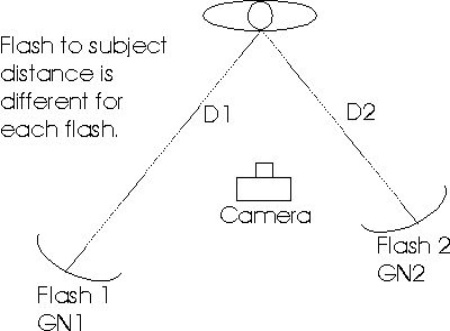|
|
|
|

Two Flashes at Same Distance From Subject
Total GN = Squareroot(GN1^2 + GN2^2); Use distance from flash to subject to find aperture.
John A. Lind
|
|
|
|

Two Flashes at Different Distances From Subject
Total GN = Squareroot[GN1^2 + (GN2*D1/D2)^2]; Use distance from Flash #1 to subject (D1) to find aperture.
John A. Lind
|
|
|
|
Ester,
Wish I had seen this question earlier! I worked this problem out a while ago.I am uploading two images for this. One shows the flash units at the same distance from the subject and the other for different flash distances. If you are using fixed flash output on both, and _no_ automatic control of the flash output (from either the camera or sensors on the flashes), here is how to find the total Guide Number for the amount of light: 1. Convert the GN rating for each flash you are using to the GN for the film speed you are using. You can do this step well in advance if you know what film speed you will be using. Get the GN rating for each flash from its specifications. This is typically given for ISO 100 in feet (sometimes meters; sometimes both). Important: If you have a switch that can reduce the power output to 1/2, 1/4, etc. and you set the flash for reduced power, then use the GN rating at the reduced power setting! If the specifications do not show what it is for ISO 800, then use this equation to convert an ISO 100 Guide Number to your film ISO:
Squareroot(FilmISO/100) * Flash GN for ISO 100 Example:
If your flash has a GN rating of 125 in feet for ISO 100 and you are using ISO 800 film: ISO 800 GN = Squareroot(800/100) * 125
ISO 800 GN = 2.83 * 125
ISO 800 GN = 350 (approximate) 2. For both flash units at the same distance from the subject:
Use the Guide Numbers for the film speed you are using in the following equation:
Total GN = Squareroot(GN1^2 + GN2^2)
GN1 = Guide Number for Flash #1 at your film ISO
GN2 = Guide Number for Flash #2 at your film ISO
[Note: "^2" means the number is squared] Example:
Flash #1 has an ISO 800 GN of 350
Flash #2 has an ISO 800 GN of 190 Total GN = Squareroot(350^2 + 190^2)
Total GN = Squareroot(122,500 + 36,100)
Total GN = Squareroot(158,600)
Total GN = 400 (approximate) To find an aperture, divide the GN by the distance from either _flash_ to subject. 3. For flash units at different distances from the subject:
You didn't mention where your main light is, so I've given this one to you in the event it's behind or in front of you (or your assistant) somewhere. Use the Guide Numbers for the film speed you are using in the following equation:
Total GN = Squareroot[GN1^2 + (GN2*D1/D2)^2]
To find an aperture, divide the Total GN by the distance from _Flash_#1_ to the subject. Example:
Flash #1 ISO 800 GN = 350
It is D1 = 15 feet from the subject
Flash #2 ISO 800 GN = 190
It is D2 = 10 feet from the subject Total GN = Sqrt[350^2 + (190*15/10)^2]
Total GN = Sqrt[122,500 + (190*1.5)^2]
Total GN = Sqrt[122,500 + 285^2]
Total GN = Sqrt[122,500 + 81,225]
Total GN = Sqrt[203,725]
Total GN = 450 (approximate)
To find an aperture, divide this number by the distance of Flash #1 to the subject. In this case it would be 450 divided by 15, or f/32. This is about two stops tighter than most apertures will go, but not on some telephotos. This is just an example, but in this situation, I'd reduce the power output of probably both flashes. 4. Caveat:
This works if most of your subject is illuminated by each flash alone, and the subject's highlights will be illuminated by both. If you are using one for extreme side or backlighting, it is even more complex and you would probably be better off using a flash meter! Hope this helps you out,
-- John
March 20, 2001
|